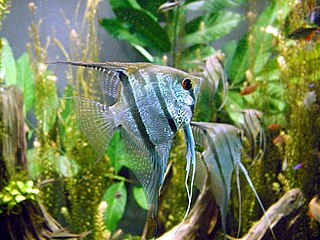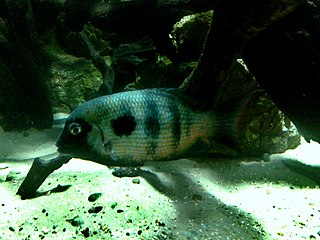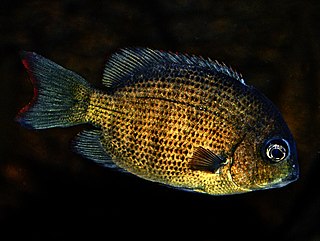
Cichlids are fish from the family Cichlidae in the order Cichliformes. Cichlids were traditionally classed in a suborder, the Labroidei, along with the wrasses (Labridae), in the order Perciformes, but molecular studies have contradicted this grouping. The closest living relative of cichlids is probably the convict blenny, and both families are classified in the 5th edition of Fishes of the World as the two families in the Cichliformes, part of the subseries Ovalentaria. This family is both large and diverse. At least 1,650 species have been scientifically described, making it one of the largest vertebrate families. New species are discovered annually, and many species remain undescribed. The actual number of species is therefore unknown, with estimates varying between 2,000 and 3,000.

Onilahy is a river in Atsimo-Andrefana and Anosy, southern Madagascar. It flows down from the hills near Betroka to the Mozambique Channel. It empties at St. Augustin, and into the Bay of Saint-Augustin.
Oxylapia is a genus of freshwater fish in the family Cichlidae. It contains the single species Oxylapia polli, known locally as the songatana. It is an endangered species, endemic to the Marolambo Rapids in the Nosivolo River in east-central Madagascar. It is threatened by habitat loss and sedimentation caused by deforestation. The only other monotypic cichlid genus in Madagascar is Katria, and it is restricted to the same region as Oxylapia. In 2010, the Nosivolo River was designated as a Ramsar Site. The Oxylapia is the conservation flagship species for the district capital Marolambo.
Paretroplus dambabe is an endangered species of cichlid from the Mahavavy du Sud river basin, including Lake Kinkony, in northwestern Madagascar. It has declined drastically due to habitat loss, invasive species and over-fishing. This relatively large and deep-bodied Paretroplus reaches almost 19 centimetres (7.5 in) in length. Although collected as early as the 1960s, it was long confused with P. petiti and therefore only described as a species in 2002.

Paretroplus is a genus of fishes in the cichlid family, all of which are endemic to lakes and rivers of Madagascar. The vast majority are threatened and restricted to the northwestern part of the island. Only P. polyactis is found in the southern half of Madagascar and only P. polyactis and P. gymnopreopercularis are found in eastern drainages. Most are restricted to freshwater, but at least P. polyactis and P. maromandia can also be seen in brackish habitats.

The damba is a species of cichlid.

The damba mipentina is a critically endangered species of cichlid fish from turbid, shallow flood-plain lakes in the Betsiboka and Ikopa River basins in northwestern Madagascar. It has declined drastically because of habitat loss, overfishing and invasive species. It is part of a captive breeding program by public institutions like London Zoo and among fishkeeping hobbyists.
Paretroplus maromandia is an endangered species of cichlid fish from fresh and brackish water in northwestern Madagascar, where known from the Maintsomalaza, Andranomalaza and Maevarano Rivers, and Lake Andrapongy. It has already been extirpated from the lake, and is threatened by habitat loss and invasive species. This relatively deep-bodied Paretroplus reaches 25 centimetres (9.8 in) in length.

Paretroplus menarambo is a species of cichlid fish.
The kotso is a species of cichlid fish from northwestern Madagascar. Currently rated as data deficient by the IUCN, this species is virtually unknown. The only known specimen is a juvenile that was collected more than 80 years ago. It is not entirely clear where it was collected, but likely from the Maintimaso River or Lake Ambanja, which both are part of the Betsiboka River drainage. Erroneously, the name P. petiti has often been applied to members of a different species, P. dambabe. The specific name honours the French zoologist and anatomist Georges Petit (1892-1973) of the Muséum national d’Histoire naturelle, who collected type.
Paretroplus tsimoly is a species of cichlid fish from the Betsiboka River basin in northwestern Madagascar. Like other members of the lamena group, it is a rheophile. This relatively elongate Paretroplus reaches about 16 centimetres (6.3 in) in length, and is closely related to P. lamenabe and P. nourissati.

Ptychochromis grandidieri is a species of fish in the family Cichlidae endemic to river basins along a large part of the eastern coast of Madagascar, although it has been recorded as far as 100 km (62 mi) inland. Uniquely in the genus Ptychochromis, this species also occurs in brackish water. It reaches 35cm in standard length. It shares a large part of its range with a cichlid from another genus, Paretroplus polyactis. The specific name honours Alfred Grandidier (1836-1921), the French naturalist and explorer who, with Henri Joseph Léon Humblot (1852-1914), collected the type.
Ptychochromis loisellei is a species of cichlid from the Mahanara River basin north of Sambava in northeastern Madagascar. It remains common within its small range, but it is threatened by habitat loss and introduced species. It reaches about 11.9 centimetres (4.7 in). The similar named Paretroplus loisellei is also restricted to the Mahanara River basin. The specific name honours Paul V. Loiselle, Emeritus Curator of Freshwater Fishes at the New York Aquarium and a researcher in, and campaigner for the conservation of, the freshwater fish of Madagascar.

The trondo mainty is a critically endangered species of cichlid endemic to the Onilahy River Basin in southwestern Madagascar. Its remaining range covers less than 10 km2 (3.9 sq mi) and it is highly threatened by habitat loss, fishing, and competition with/predation by introduced species. Another cichlid from the same basin, Ptychochromis onilahy, is probably already extinct. The trondo mainty reaches a standard length (SL) of 24 cm (9.4 in).

Ptychochromoides is a genus of cichlids endemic to Madagascar. Of the three described species, two are critically endangered and one was considered extinct until rediscovered in late 2010.
Katria is a genus of freshwater fish in the cichlid family. It contains the single species Katria katria, a vulnerable species from the Mangoro and Nosivolo Rivers in east-central Madagascar, that was formerly included in the genus Ptychochromoides. The only other monotypic cichlid genus in Madagascar is Oxylapia, and it is restricted to the same region as Katria. In 2010, the Nosivolo River was designated as a Ramsar Site. The Katria reaches about 13 centimetres (5.1 in) in length.
Ptychochromoides vondrozo is a critically endangered species of cichlid endemic to the Mananara-sud river and its tributaries near Vondrozo in southeastern Madagascar. These are deep and moderate to fast-flowing. Its entire range covers less than 100 square kilometres (39 sq mi), which makes it highly threatened from continued sedimentation caused by deforestation. It is also threatened by other species that have been introduced to the region. It reaches a length of 20.4 centimetres (8.0 in) SL.
Sauvagella robusta is a small species of fish in the family Clupeidae. It is endemic to the Amboaboa and Mangarahara River Basins in northern Madagascar. This relatively slender fish reaches a length of 6.8 cm (2.7 in), and is overall pale yellowish with silvery on the lower parts. Its current conservation status is unclear, but the cichlid Ptychochromis insolitus, which is highly threatened from habitat loss, is native to the same region. Sauvagella robusta is known to survive at least in Lake Tseny.

The green chromide is a species of cichlid fish that is native to fresh and brackish water habitats in some parts in India such as Kerala, Goa, Chilika Lake in Odisha and Sri Lanka. The species was first described by Marcus Elieser Bloch in 1790. This species and other members of the genus Etroplus are relatively closely related to the Paretroplus cichlids from Madagascar.

Ptychochromis insolitus, also known as the Mangarahara cichlid or joba mena, is a species of cichlid endemic to certain river systems in northern Madagascar. This critically endangered fish is threatened by habitat loss and competition from introduced species; after the last-known female was killed during a breeding attempt, its conservation received significant international attention as London Zoo launched a media campaign to identify any remaining individuals. A remnant population was discovered by aquaculture entrepreneur Guy Tam Hyock in 2013, and breeding programs in Madagascar and at Toronto Zoo have resulted in thousands of successful hatchlings.










